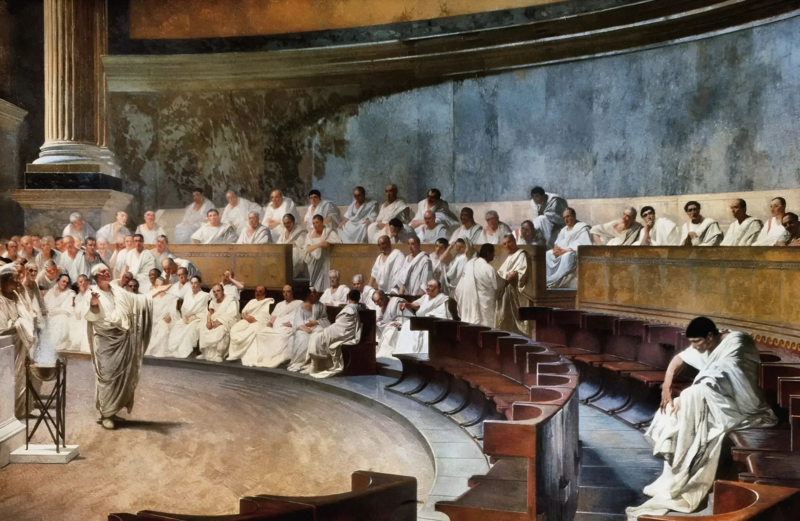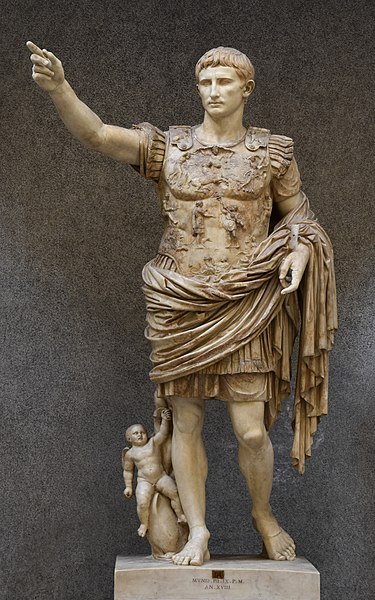Roman Culture
In many ways it is difficult to classify a single collection of qualities together to define a cohesive single 'Roman Culture'. Rome expanded so broadly and over such a wide area of the world that it came to incorporate many features and aspects of other cultures, absorbing them through cultural syncretism. Indeed, much of 'Roman culture' itself was adopted and adapted from the Greeks and neighbouring Italian states early in its history, long before it conquered much of the world. It is perhaps this feature of the Romans that is the most defining aspect of their own culture, their ability to absorb and adapt the traditions of their subjects over time is one of the reasons that their legacy was so long-lasting and impactful. Whether its the Gallo-Roman culture that emerged in central Europe following the conquest of Gaul, or the state adoption of Christianity as an official religion in the late empire, Rome was an ever-changing mixing pot of peoples, religions, arts, and social structures. Despite this, Rome did have some particular aspects of its own traditions that lasted throughout the republic and empire, and some of those are covered here.
Class Structure
Rome was a traditional society that favoured conservative values and long-standing precedents as the underlying foundation for societal stability. As such, the populace as a whole was subject to a rigid class structure that denoted what a person could, and could not, do. Across the majority of Roman history these classes could be defined quite clearly into four sections, and were most often tied to someones birth and ancestry, rather than wealth or status. Namely these groups were the patricians (the aristocratic class), the equites (wealthy commoner citizens), the plebeians (non-wealthy commoner citizens), and slaves. Citizenship rights were not universal and only applied to men, initially (when Rome was a city state in Italy) citizenship was limited to those born of Roman male citizens, as Rome conquered the Italian peninsula it eventually granted rights to neighbouring subjugated people to effectively absorb them into the state. As Rome expanded beyond Italy, those who were conquered were merely subjects - although some men could gain citizenship through military service - until the edict of Emperor Caracalla in 212 CE, which granted Roman citizenship to all free men of the empire. This of course did not include slaves.
The status of patrician was one based on (oftentimes unclear or legendary) ancestry, with patricians said to have been descended from the first 100 men chosen to be senators by Rome's legendary founder Romulus. For much of the Republican period the patricians held a high proportion of senatorial seats, as well as much of the most coveted agricultural land and a high proportion of wealth, which due to the familial component of their status was typically generational. Over time the importance of the distinction between patrician and plebeian would diminish, largely due to plebeian uprisings that disrupted the social order and granted the common citizen greater rights over time.
The equites were technically a part of the plebeian class, although distinctly defined by their high amount of wealth, and therefore seperate from the wider plebeian populace. Equites gained their name from the military role in the cavalry with which they were initially associated. High wealth individuals who were eligible for military service served in the cavalry forces of the Roman army, as they were able to afford their own horse as a matter of course. Although this association became less important over time, as the use of Roman citizen cavalry diminished, the political power of the equites increased alongside their wealth. This is due in no small part to their disproportionate voting power in the political system (see below).
The plebeians comprised the majority of Roman citizens, and the poorest of them - known as the proletarii - comprised the majority of the plebeians. Although they were extremely disadvantaged in the early republic, both in terms of material wealth and the law, they would gain more rights over time through various uprisings in the early-to-mid republican period. Despite these gains most of the plebeians relied on the wealthy to live, working on their farms, serving in the army, or at best owning a small plot of their own land. Additionally, despite being the majority of the population, the plebeians had a disproportionately small share of the votes in the republican political system.
The Political System

For much of its history Rome operated under a republican constitution and form of government. On paper this meant that Rome was a direct democracy, with all elections being held in public in Rome, individuals campaigning for office, and individuals voting for their preferred candidates who served for fixed terms. However, the Roman republic was in fact an oligarchy in practice. The wealthiest members of society, that is the patricians and equites, had the most voting power, and controlled most political positions.
Political offices were known as magistracies, filled each year with the elected magistrates. Most magistrates served for only one year in office, and the magistracies that commanded Rome's military operations could (at least on paper but not in practice), only preside in such an office once every ten years. As Rome began its history as a kingdom that was overthrown and formed into a republic due to tyranny, these limited terms of office were to prevent tyranny arising again. The typical magistracies were as follows:
- The Censor (Oversaw public morality and broad government finances)
- Consuls and Praetors (Commanded the military forces of Rome)
- Aediles (Controlled the maintenance of public buildings and festivals)
- Quaestors (Finance related positions)
- Military Tribunes (Elected to be high-ranking officers in the military and command smaller forces)
- Tribunes of the Plebs (Solely elected by plebeians and intervened and enacted laws on their behalf)
During the republican period voting and decisions were made in 'assemblies', here those who were eligible to vote in said assembly would gather, if they could, and vote on candidates for each magistracy office. Most magistrates were elected in the Centuriate Assembly, and it is here where Rome's oligarchical structure is evident. In the Centuriate Assembly the citizen population was divided into a voting 'century' based on their wealth, with a certain proportion of votes afforded to each century. Whichever candidate won the most votes in each century would receive the all the votes afforded to that century. However, the top two 'centuries' or classes of voters held more than 50% of the votes, this allowed the wealthiest portion of Roman citizens to outvote all of the lower centuries/classes quite easily. The only political office where this was not the case was the Tribune of the Plebs. The Tribune of the Plebs was elected only by the plebeian class, and due to protest action by the plebeians in the early republic this office was made sacrosanct. This meant that the Tribune of the Plebs was viewed as under the protection of the wider plebeian populace, protecting him from attack, these Tribunes were also later endowed through further mass action with extra powers. These powers included most notably the power of 'veto', which allowed them to veto any unpopular legislation that was about to be passed, as well as the right to intervene on the behalf of plebeians who were being treated unfairly. While seemingly rather benign, the Tribune of the Plebs became a powerful office in the late republic, where populist figures used their influence to rile up the general populace and hinder the ambitions of their political rivals through the office's unique powers.
As Rome changed into an empire, many of the offices that were once held by elected representatives became absorbed by the emperor, or simply became symbolic stepping stones in a political system for the upper class members of Roman society. In the empire the emperor held supreme authority over the state, and the vestiges of the republican system merely remained in an effort to legitimise their rule throught the continuation of tradition.
Art & Architecture

Roman art, and particularly the architecture of Rome itself, are famed worldwide today, but in reality Roman art is complex mixture of influences from other cultures and centuries of expansion. Most notably, Rome took early influences from classical Greek art and architecture, but also their Etruscan neighbours on the Italian peninsula. These informed the realistic and highly detailed statuary that is famous today, but also other aspects of Roman art such as pottery, architecture, and literature. In fact, much of the surviving classical Greek statuary that was passed down to us today is actually Roman copies of famous Greek works, with the original versions being lost to history.
Roman art was not static in style, although it evolved slowly over time. In the early republic a more 'realistic' style was favoured for Roman portraiture, which detailed the wrinkles, age, and imperfections of the male subject in order to highlight his wisdom and experience. This remained a popular form until the beginning of the empire. Under Emperor Augustus (Fig. 02) a new programme of statuary depicted the emperor as smooth, youthful, and godlike. Allusions to his supposed divine ancestry were made through symbolic elements of his portraits, all done in the name of reinforcing his legitimacy as the sole authority in a new Roman empire. When Christianity was later adopted in the empire and began to spread, the art also changed. A more abstract style of portraiture emerged, and greater focus was given to elements of the face such as the eyes, or symbols of the emperor's piety, with less regard for accurate proportions. Besides sculpture the Romans also engaged in other forms of art such as fresco paintings, mosaics, jewelry making, fine furniture, glass works, and gemstone engraving. Some of the most famous surviving Roman artwork is found in Pompeii, and includes wall paintings of mythological stories, plants and animals, and even erotic scenes.
In architecture Rome again absorbed much of the style of classical Greece and Etruscan forms, however the Roman propensity for engineering, combined with the resources of empire, allowed for constructions on a much grander scale than ever before. One only needs to look at the Colosseum or the Pantheon to see the results of Roman ingenuity that is guided by classical forms. These structures have stood the test of time not only because of Rome's capital being well protected and politically stable for centuries, but also because of inventions and engineering such as Roman concrete, which seals its own cracks through the absorption of water. Due to the mass urbanisation of Rome itself the Romans also pioneered other elements of architecture. Aqueducts spanned miles to bring water to the city, buildings covered entire city blocks to form an early version of apartment buildings, and Rome constructed roads all across the empire to ease travel, many modern roads overly the general path of these ancient routes today.
Over time what we would identify as 'Roman' art faded away in favour of new styles as the world progressed from antiquity into the Middle Ages. While some may see this as a step back in terms of complexity and skill it was really an evolution of culture which had absorbed so many other people. These changes were preceded by a cultural syncretism across the empire that was expressed in various forms, such as Gallo-Roman art. In reality the change is a symbol of how successful Rome truly was, its ability to maintain an overarching authority across so many regions and cultures is expressed in the changes that are seen going into the Middle Ages.